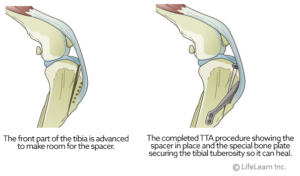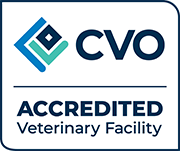Cruciate repairs are used to abolish tibial thrust (sliding), whether by changing the orientation of the forces acting on the stifle (knee), or by implanting a false ligament. With each surgery, the joint is opened and examined. Any damaged tissues, such as ligament debris or torn menisci, are removed to limit further trauma and swelling. Two types of surgical repair are offered at Northwestern Veterinary Hospital.
1) Tibial Tuberosity Advancement (TTA)
The TTA procedure is a “dynamic stabilization technique”, this means that while the legs is in use and weight bearing, the knee is stabilized and does not experience tibial thrust. This procedure does not abolish tibial thrust while the leg is not being used.

This technique involves advancing the attachment of the patellar tendon (ligament associated with the knee cap). The tibial crest (shin bone), which is one attachment of the patellar tendon, is cut and re orientated. This re orientation changes the forces acting on the tibia when the quadriceps muscle contracts, this abolishes instability in stifle joint. Once the tibia has been cut a titanium implant and a bone graft is used to secure the fragment.
This technique is procedure of choice for larger dogs and/or dogs who can experience implant failure with the heavy suture technique. Implant failure is typically associated with dogs who are not restricted during the recovery period.
2) Extracapsular Repair using Heavy Sutures
This technique involves the reconstruction of a cranial cruciate ligament using a large suture material (fishing leader line), which is placed outside the joint capsule. The suture is anchored at the back of the knee, passed through a tunnel drilled in the tibial crest.
The goal of this technique is to provide temporary stability for the stifle to allow the development of fibrosis (scar tissue) around the joint.
This technique is often adequate for lighter weight dogs. The heavy suture method can be used in larger dogs, but overweight dogs, often experience implant failures as they often generate a significant amount of force and stress on the implant.
Many dogs will go home with a leg bandage post-operatively, which aids in limiting swelling and assists in restricting movement of the leg.
Pain Management and Medication
Managing pain, before, during and after surgery, is crucial to the success of surgery. Most patients will spend at least one night in hospital after surgery for monitoring, restriction and pain control. All dogs will be placed on pain management post-operatively, as well as restricted activity.
Antibiotic medication is also often prescribed after surgery to help prevent infections. It is strongly recommended that these medications are used until completion to help prevent the development of infections at the surgical site, and to prevent the development of antibiotic resistance.
Restricted Activity
All dogs will be placed on restricted activity after surgery, to help in healing and limit further damage.
Rehabilitation and Follow-up
Physical rehabilitation is an important component of the healing process. It aides in the return to normal function and pain management. A rehabilitation program will be recommended for your pet at the time of discharge. It is important to understand that the return to normal function will take time and effort on your part, but with dedication and diligence your dog can enjoy a long and healthy life once the injured leg is healed. If at anytime during the rehabilitation period you have questions, please contact the clinic.
Follow-up/recheck exams are recommended to monitor post-operative healing and progress.
Cost of Procedures
Surgical correction of a torn cruciate ligament is a major undertaking, both financially and in terms of time investment on the part of the owner. Some of the costs include initial exam and rechecks/follow up appointments, x-rays with or without general anesthesia to assess the stifle, surgery and medications. Surgery costs vary depending on the surgical technique used; please contact us for an updated cost structure.
Complications and Risks
Although infrequent, risk of surgical complications do exist. It is important to be aware of the risks and potential complications prior to surgery so that if any issues arise they can be dealt with promptly. Some complications include:
-
Infections occasionally happen after surgery, but antibiotics will be used during and after surgery to limit its occurrence. With careful monitoring of the incision site and of your dogs behaviour, infections can be easily evaded.
-
Implant failure involves the breakdown of the surgical material used to stabilize the knee. This can occur for various reasons such as stress or excessive force being applied to the device due to weight, too much physical activity before adequate healing, infections or other trauma. If implant failure occurs a second surgery may be needed. Monitoring and restriction your dog will help limit these from occurring.
-
As with any anesthetic procedure, there are inherent risks associated with general anesthesia.
-
Nerve damage is a rare complication associated with placement of extracapsular heavy sutures, as the implant is placed close to the anatomical location of a nerve the runs down the outside of the leg.
If you have any questions about these or other complications or risks, please discuss them with your veterinarian.

